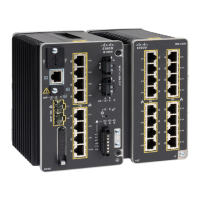13-14
Cisco IE 3000 Switch Software Configuration Guide
OL-13018-01
Chapter 13 Configuring VLANs
Configuring VLAN Trunks
For more details about the show command options and explanations of output fields, see the command
reference for this release.
Configuring VLAN Trunks
These sections contain this conceptual information:
• Trunking Overview, page 13-14
• Default Layer 2 Ethernet Interface VLAN Configuration, page 13-16
• Configuring an Ethernet Interface as a Trunk Port, page 13-16
• Configuring Trunk Ports for Load Sharing, page 13-20
Trunking Overview
A trunk is a point-to-point link between one or more Ethernet switch interfaces and another networking device
such as a router or a switch. Ethernet trunks carry the traffic of multiple VLANs over a single link, and you
can extend the VLANs across an entire network. The switch supports IEEE 802.1Q encapsulation.
You can configure a trunk on a single Ethernet interface or on an EtherChannel bundle. For more
information about EtherChannel, see
Chapter 33, “Configuring EtherChannels and Link-State
Tracking.”
Ethernet trunk interfaces support different trunking modes (see Table 13-4). You can set an interface as
trunking or nontrunking or to negotiate trunking with the neighboring interface. To autonegotiate
trunking, the interfaces must be in the same VTP domain.
Trunk negotiation is managed by the Dynamic Trunking Protocol (DTP), which is a Point-to-Point
Protocol. However, some internetworking devices might forward DTP frames improperly, which could
cause misconfigurations.
To avoid this, you should configure interfaces connected to devices that do not support DTP to not
forward DTP frames, that is, to turn off DTP.
• If you do not intend to trunk across those links, use the switchport mode access interface
configuration command to disable trunking.
• To enable trunking to a device that does not support DTP, use the switchport mode trunk and
switchport nonegotiate interface configuration commands to cause the interface to become a trunk
but to not generate DTP frames.
show interfaces [vlan
vlan-id]
Privileged EXEC Display characteristics for all interfaces or for the specified
VLAN configured on the switch.
show vlan [id vlan-id] Privileged EXEC Display parameters for all VLANs or the specified VLAN on
the switch.
Table 13-3 VLAN Monitoring Commands (continued)
Command Command Mode Purpose
